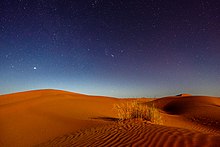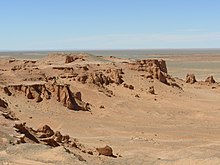A desert is a landscape where little precipitation occurs and, consequently, living conditions create unique biomes and ecosystems. The lack of vegetation exposes the unprotected surface of the ground to denudation. About one-third of the land surface of the Earth is arid or semi-arid. This includes much of the polar regions, where little precipitation occurs, and which are sometimes called polar deserts or "cold deserts". Deserts can be classified by the amount of precipitation that falls, by the temperature that prevails, by the causes of desertification or by their geographical location.
AFRICA :
- Kalahari Desert – a desert covering much of Botswana and parts of Namibia and South Africa
- Karoo Desert – a desert covering parts of southern South Africa
- Namib Desert – a desert in present-day Namibia
- Danakil Desert – a desert lying in the Afar Triangle and covering northeastern Ethiopia, southern Eritrea, southern Djibouti and northwesternmost Somalia
- Eritrean Coastal Desert – a desert lying along the southern part of the coast of Eritrea and the coast of Djibouti
- Guban Desert – a desert lying along the coast of northwestern Somalia
- Grand Bara Desert – a desert covering parts of south Djibouti
- Chalbi Desert – a desert in northern Kenya along the border with Ethiopia
- Nyiri Desert – a desert located in southern Kenya along the border with Tanzania
- Lompoul Desert – a desert lying in northwestern Senegal between Dakar and Saint-Louis
- Sahara Desert – Africa's largest desert and the world's largest hot desert which covers much of North Africa comprising:
- Ténéré – a desert covering northeastern Niger and western Chad

Sahara Desert - Tanezrouft – a desert covering northern Mali, northwestern Niger as well as central and southern Algeria, at the west of the Hoggar Mountains
- El Djouf – a desert which covers northeastern Mauritania and parts of northwestern Mali
- Djurab Desert – a desert covering northern central Chad
- Tin-Toumma Desert – a desert covering southeastern Niger, at the south of the Ténéré
- Libyan Desert (also called Western Desert) – a desert covering eastern Libya, western Egypt and northwestern Sudan at the west of the Nile River
- White Desert – a desert covering a part of western Egypt and located in Farafra, Egypt
- Eastern Desert – a desert covering eastern Egypt and northeastern Sudan between the Nile River and the Red Sea
- Nubian Desert – a desert covering northeastern Sudan between the Nile River and the Red Sea
- Bayuda Desert – a desert covering eastern Sudan located just at the southwest of the Nubian Desert
- Sinai Desert – a desert located on the Sinai Peninsula in Egypt
- Atlantic Coastal Desert – a desert lying along the western coast of the Sahara Desert and occupies a narrow strip in Western Sahara and Mauritania
ASIA :
- Arabian Desert – desert complex on the Arabian Peninsula comprising:
- Al Khatim Desert – a desert near Abu Dhabi
- Al-Dahna Desert – a desert being the main central division of the Arabian Desert and covering parts of Saudi Arabia
- Empty Quarter (Rub' al Khali) – the world's largest sand desert and covering much of Saudi Arabia, Oman, the United Arab Emirates and Yemen
- Nefud Desert – a desert in northern part of the Arabian Peninsula
- Ramlat al-Sab`atayn – a desert in north-central Yemen
- Wahiba Sands – a desert covering great parts of Oman

Aerial view of Negev - Judaean Desert – a desert in eastern Israel and the West Bank
- Negev – a desert located in southern Israel
- Bromo Sand Sea – a volcanic desert in Bromo Tengger Semeru National Park, East Java, Indonesia
- Dasht-e Kavir – a desert in central Iran
- Dasht-e Lut – a large salt desert in southeastern Iran
- Polond Desert – a desert in eastern Iran
- Maranjab Desert – a desert in central Iran
- Katpana Desert – a cold desert in Pakistan
- Indus Valley Desert – a desert located in Pakistan
- Kharan desert – a desert located in Pakistan
- Syrian desert – a desert located in Syria, Jordan and Iraq
- Thal Desert – a desert in Pakistan
- Thar Desert – a desert in India and Pakistan

Gobi in Mongolia - Cholistan Desert – a desert in Pakistan
- Dasht-e-Margo – a desert in southwestern Afghanistan
- Kyzyl Kum – a desert in Kazakhstan and Uzbekistan
- Kara Kum – a large desert in Central Asia
- Lop Desert – a desert in China
- Ordos – a desert in northern China
- Kubuqi Desert – a desert in northern China
- Mu Us Desert – a desert in northern China
- Gobi – a desert in Mongolia and China
- Badain Jaran Desert – a desert in China
- Hami Desert – a desert in China
- Tengger Desert – a desert in China
- Taklamakan – a desert located in China
- Gurbantünggüt Desert – a desert located in northwestern China
- Kumtag Desert – a desert in northwestern China
- Karapinar Desert – a desert in Southern Central Anatolia
EUROPE :
- Bardenas Reales – a semi-arid desert in Navarre, Spain (455 km2; 176 sq mi)[1]
- Cabo de Gata-Níjar Natural Park – an arid desert in Almeria, Spain (460 km2; 180 sq mi)[2][3]
- Monegros Desert – a semi-arid desert in Aragón, Spain[4]
- Tabernas Desert – an arid and semi-arid desert in Almería, Spain (280 km2; 110 sq mi)[5]
Other European nations
- Oleshky Sands – a sand semi-arid desert in Kherson Oblast, Ukraine
NORTH AMERICA :
- Chihuahua Desert – a desert in Mexico and the United States
- Great Basin Desert
- Mojave Desert – a desert in the United States
- Red Desert (Wyoming)
- Sonoran Desert – a desert in the United States and Mexico
- Thompson Plateau – a desert in Canada
OCEANIA :
- Central Desert – a central Australian desert
- Gibson Desert – a central Australian desert
- Great Sandy Desert – a northwestern Australian desert
- Great Victoria Desert – the biggest desert in Australia
- Little Sandy Desert – a western Australian desert
- Simpson Desert – a central Australian desert
- Strzelecki Desert – a south-central Australian desert
- Tanami Desert – a northern Australian desert
SOUTH AMERICA :
- Atacama Desert – a desert in Chile and Peru
- La Guajira Desert – a desert in Colombia and Venezuela
- Monte Desert – in Argentina, a smaller desert above the Patagonian Desert
- Patagonian Desert – the largest desert in the Americas, located in Argentina
- Sechura Desert – a desert located south of the Piura Region of Peru
- Jalapão – a desert park in Tocantins, Brazil
POLAR REGIONS :
- Antarctic Desert – the largest desert in the world[6][7]
- McMurdo Dry Valleys – a series of extremely dry, snow-free valleys in Victoria Land
- Meyer Desert – a small desert close to the South Pole
Arctic
- Arctic Desert – the second largest "desert" in the world, though it consists of frozen ocean, land ice, and tundra, so (like the rest of this section) not a desert climate in any conventional sense
- North American Arctic – a large tundra in Northern America
- Greenland – mostly covered by land ice, like Antarctica
- Russian Arctic – a large tundra in Russia
Comments
Post a Comment